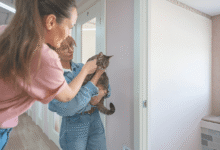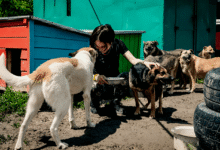
Introducing Your New Pet to Existing Pets
Introducing your new pet to existing pets Learn expert tips for smooth introductions and harmonious pet relationships in your home.
Introducing a new pet to your existing pets is an exciting yet delicate process that requires careful planning and patience. Whether you’re bringing home a playful puppy, a curious kitten, or a small animal like a rabbit or guinea pig, the way you manage the first introductions can set the tone for their future relationship. Rushing this process can lead to stress, territorial disputes, or even aggression, while a well-structured approach fosters harmony and helps your pets form positive bonds.
Before the new arrival steps paw into your home, it’s crucial to understand your current pet’s temperament and prepare your household for a smooth transition. Introducing a new pet to your existing pets successfully involves gradual introductions, scent swapping, and supervised interactions to ensure safety and comfort for all animals involved. This guide will walk you through every step from pre-introduction preparations to long-term coexistence so you can create a peaceful and happy multi-pet household.
Introducing Your New Pet to Existing Pets a Comprehensive Guide
Territorial Nature of Pets
Most animals, whether dogs, cats, or small pets, are instinctively territorial. They view their home as their domain, and a sudden intruder can trigger defensive behaviors. Dogs may bark, growl, or posture to assert dominance. Cats often hiss, swat, or hide to establish boundaries. Small pets (like rabbits or guinea pigs) may freeze, flee, or even show signs of stress-induced illness. Understanding these reactions helps prevent forced interactions that could escalate into fights.
Assessing Your Current Pet’s Temperament
Every pet has a unique personality, and their past experiences shape how they’ll react to a newcomer. Sociable pets may adjust quickly, showing curiosity rather than aggression. Shy or anxious pets might retreat or avoid interaction, needing extra time. Dominant or aggressive pets could challenge the new arrival, requiring slow, controlled introductions. Observing your pet’s behavior around other animals (e.g., during walks or vet visits) can provide valuable clues.
Considering the New Pet’s Background
A new pet’s history greatly influences their adjustment period. Rescue or animal shelter may have trauma, making them fearful or defensive. Puppies/kittens are often energetic and unaware of boundaries, which might annoy older pets. Previously housed pets (e.g., from multi-pet homes) might adapt faster but could also carry territorial habits. Tailoring introductions based on both pets’ personalities and histories ensures a smoother transition. By acknowledging these factors, you can create a structured introduction plan that minimizes stress and fosters positive relationships between your pets.
Preparing Your Home for the New Arrival
Create a Safe Space for the New Pet
Before bringing your new pet home, set up a separate area equipped with all their essentials food and water bowls, bedding, toys, and a litter box (for cats). This designated space Reduces stress by giving the newcomer time to adjust to their new environment. Prevents territorial conflicts by keeping pets separated initially. Allows controlled introductions once both animals seem comfortable. Choose a quiet room where the existing pet doesn’t spend much time and use baby gates or closed doors to maintain separation.
Scent Swapping for Familiarization
Animals rely heavily on smell to process new information. Help them get acquainted before meeting face-to-face by Rubbing a soft cloth on one New Pet and placing it near the other’s resting area. Switching bedding or toys between pets to mix their scents naturally. Using pheromone products (like Feliway for cats or Adaptiv for dogs) to promote calmness. This gradual scent exchange prevents sudden reactions during the first physical introduction, making the eventual meeting less stressful.
The First Introduction Slow and Controlled
The initial meeting should be gradual and supervised. For dogs, consider a neutral location like a park to prevent territorial behavior. Keep both dogs on leashes and allow them to sniff each other from a distance. Look for positive body language loose wagging tails and relaxed postures are good signs. For cats, start with a barrier such as a baby gate or cracked New Pet. Let them see each other without direct contact, and reward calm behavior with treats. If either pet shows aggression, separate them and try again later. Small animals should be introduced in a neutral cage or playpen to prevent chasing or fighting.
Monitoring and Building Positive Associations
After the first meeting, continue supervised interactions while keeping the pets separated when unsupervised. Feed them on opposite sides of a door or gate so they associate each other’s presence with positive experiences like mealtime. Gradually increase their time together as they become more comfortable. If conflicts arise, avoid punishment instead, redirect their attention with toys or New Pet. Over time, most pets will learn to coexist peacefully, though some may never become best friends. The key is patience and consistency.
Addressing Common Challenges
Handling Aggression and Setbacks
When introductions don’t go as planned, immediate action prevents escalation Separate immediately at the first sign of serious aggression (growling, lunging, or attacking) to avoid injuries. Consult professionals like certified animal behaviorists or trainers for persistent New Pet. Reset the process by going back to scent swapping and visual introductions before attempting physical contact again. Remember that some pets need weeks or months to adjust, especially those with traumatic pasts or strong territorial instincts. Patience is key forcing interactions will only worsen tensions.
Resource Management in Multi-Pet Homes
Prevent competition by ensuring adequate resources Provide separate essentials (food bowls, water stations, beds) in different areas. Follow the “N+1 rule” always have one more resource than pets (e.g., 3 litter boxes for 2 cats). Create vertical space (cat trees, shelves) and multiple retreat options to reduce confrontations. For pets that may never become friends, focus on creating a peaceful coexistence through structured routines and clear boundaries. Many pets learn to tolerate each other when given proper space and time.
Read More: Celebrating Holidays with Your Pet Safety and Fun Ideas
Conclusion
Introducing a new pet to your existing pets is a journey that requires patience, understanding, and careful planning. While some animals may bond quickly, others need weeks or even months to adjust to their new companion. By following gradual introduction techniques, monitoring interactions, and creating positive associations, you can significantly reduce stress and prevent conflicts. Remember that every pet has its own personality, and forcing relationships will only lead to tension allowing them to progress at their own pace is key to long-term harmony.
Ultimately, the effort you put into introducing a new pet to your existing pets will pay off in a peaceful, happy household where all your furry (or feathered) family members feel secure. Whether they become inseparable playmates or simply learn to coexist respectfully, your thoughtful approach ensures a smoother transition for everyone involved. With time, consistency, and plenty of positive reinforcement, your pets can build a relationship that enriches their lives and yours for years to come.
FAQs
How long does it take for pets to get used to each other?
The adjustment period varies some pets bond within days, while others may take weeks or months. Patience is key.
What if my pets fight during the introduction?
Separate them immediately and try again later. If aggression persists, consult a professional trainer.
Can I leave my pets alone together right away?
No always supervise initial interactions and separate them when unsupervised until they are fully comfortable.
Should I punish my pet for growling or hissing?
No punishment can increase stress. Instead, redirect their behavior with positive reinforcement.
What if my older pet rejects the new pet completely?
Some pets may never become close, but with proper management, they can learn to coexist peacefully.







